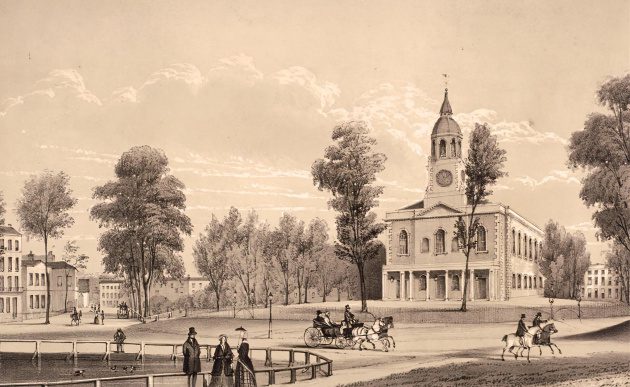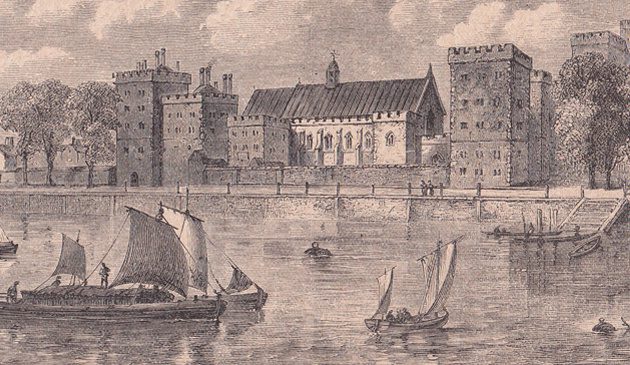The Bishops of London and Fulham Palace

Caption: The West Court of Fulham Palace with its surrounding Tudor buildings that were constructed in the late 15th century. The courtyard is entered through ancient oak gates and, apart from minor changes such as the addition of a clock in the 18th century, has looked the same since the 16th century. The clock bell is from 1676.
The Bishop of London is the most senior bishop in the Church of England after the Archbishops of Canterbury and York, and is a member of the House of Lords. Fulham Palace, beside the Thames, was the manor house and home of the bishops for almost 1,300 years until 1973.
The earliest record of a Bishop of London was when three bishops, from London, York and Lincoln, attended the Council of Arles, convened by the Roman Emperor Constantine in 314AD. Christianity was then on an unstable footing in England and the Saxons who arrived in the following centuries were pagan. Pope Gregory sent a group of monks to England in 601 to establish Christian provinces at the former Roman provinces centred on London and York. Archbishop of Canterbury Augustine consecrated Melitus, one of those monks, as Bishop of London. King Ethelbert founded the church of St. Paul in London as the episcopal seat of Melitus. The Bishop set about the work of converting to Christianity the people of the diocese, which covered what later became Essex, Middlesex (including London), and part of Hertfordshire. Since Melitus the line of the Bishops of London has remained unbroken. Bishop Sarah Mullally was ordained as the 133rd Bishop of London in 2018, the first woman to hold the post. St. Paul’s Cathedral remains the principal church of the Diocese of London, covering 277 square miles north of the Thames.
Throughout much of history the role of the Bishops of London was important in national affairs, often as the holder of the post of Lord Privy Seal, and was occasionally the last step before elevation to the role of Archbishop of Canterbury. Bishops of London also played the role of Bishop of the Colonies, which was reduced to just the West Indies after the American War of Independence. The City of Westminster sits within the Diocese of London and the bishops are usually appointed as Dean of His (or Her) Majesty’s Chapels Royal, which includes the chapels of St. James’s Palace and the Tower of London.
There have been many occasions when the Bishop of London took part in events of national importance. Bishop Robert de Sigillo was captured and held by Geoffrey de Mandeville in 1141 during the civil war between King Stephen and Empress Matilda. Bishop Simon Sudbury acted as an ambassador for King Edward III, translated to Archbishop of Canterbury in 1375 and elevated to Lord Chancellor of England in 1380. During the Peasants’ Revolt of 1381 he was dragged out of the Tower of London by the rioters and beheaded on Tower Hill. Nicholas Ridley was the only person to serve as Bishop of both London and Westminster. He was burned at the stake at Oxford during the reign of Queen Mary for failing to renounce his Protestant beliefs and for supporting Lady Jane Grey to succeed Edward VI. As a supporter of King Charles I William Laud played a major role in the events that led up to the Civil Wars of the 1640s. He was translated from Bishop of London to Archbishop of Canterbury in 1633. His desire to force religious reforms led to his imprisonment in the Tower of London and his beheading on Tower Hill in 1645. Bishop William Juxon often acted as an advisor to Charles I and attended the King’s execution at Whitehall Palace in January 1649 to whom Charles famously spoke his last word: “Remember!”. After the King’s death the role of bishops was abolished and remained so until the Restoration of the Monarchy in 1660 when Juxon was appointed as Archbishop of Canterbury. Bishop William Howley was translated to Archbishop of Canterbury in 1828 and officiated at the coronations of both William IV and Queen Victoria.
Fulham Manor was purchased by Walhere, the 5th Bishop of London, from the Bishop of Hereford in around the year 700. It was only one of many held by the Bishops of London, who in 1500 owned 24 manors around the London area. It is thought that the name Fulham is derived from the Saxon Fullenhame, meaning habitation of birds due to the abundance of water fowl. Much of the waterside along the Thames was then swamp that was covered at high tide. The manor included what is now Fulham, Hammersmith, Acton, Ealing and Finchley. A letter written by Waldhere is now the oldest surviving document on parchment in Western Europe. London at that time was on the border of the competing kings of the East Saxons (Essex), West Saxons (Wessex), South Saxons (Sussex), and Kent.


